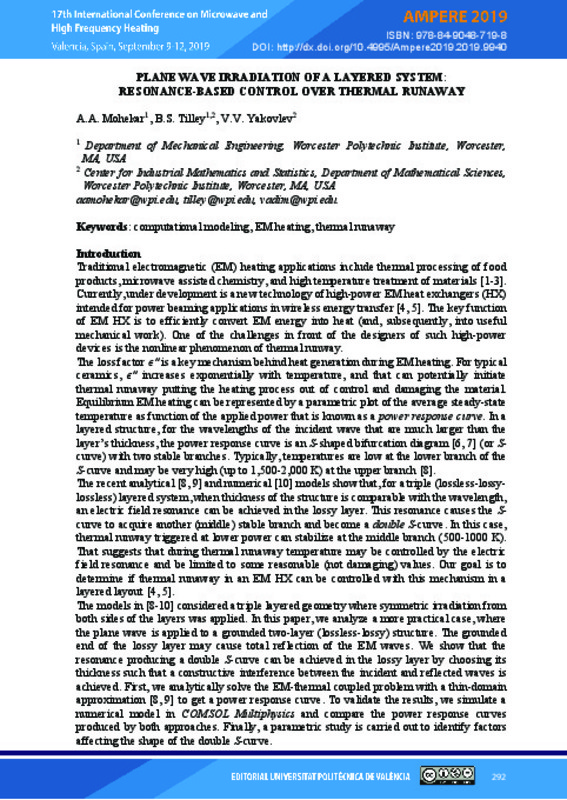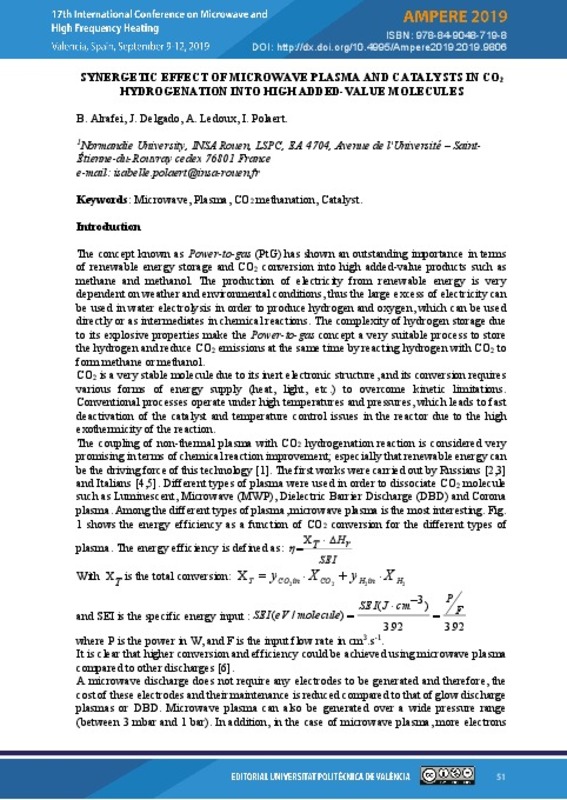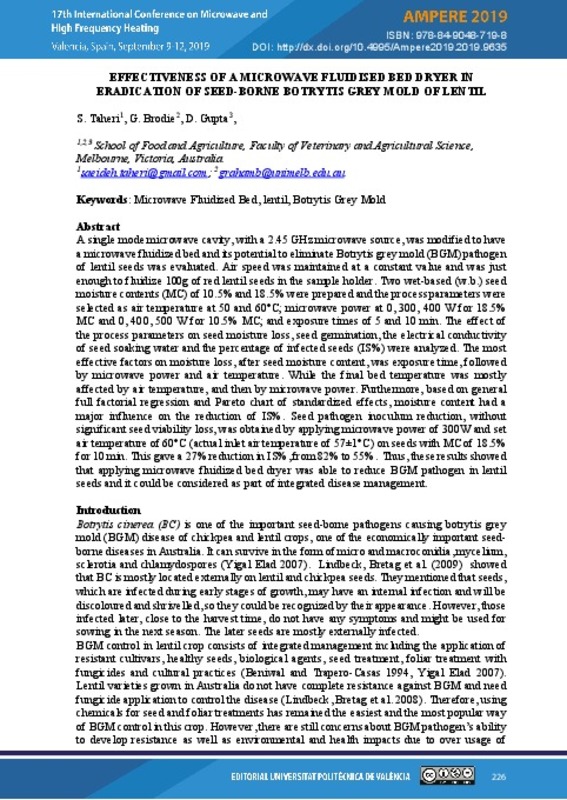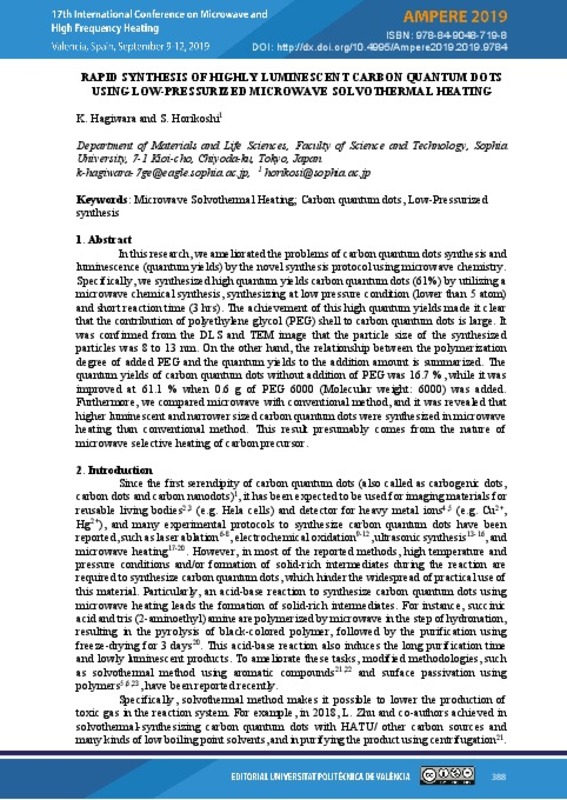JavaScript is disabled for your browser. Some features of this site may not work without it.
Buscar en RiuNet
Listar
Mi cuenta
Estadísticas
Ayuda RiuNet
Admin. UPV
Plane wave irradiation of a layered system: resonance-based control over thermal runaway
Mostrar el registro sencillo del ítem
Ficheros en el ítem
| dc.contributor.author | Mohekar, Ajit
|
es_ES |
| dc.contributor.author | Tilley, Burt
|
es_ES |
| dc.contributor.author | Yakovlev, Vadim
|
es_ES |
| dc.date.accessioned | 2019-11-05T07:34:09Z | |
| dc.date.available | 2019-11-05T07:34:09Z | |
| dc.date.issued | 2019-10-15 | |
| dc.identifier.isbn | 9788490487198 | |
| dc.identifier.uri | http://hdl.handle.net/10251/130218 | |
| dc.description.abstract | [EN] The loss factor of a material is a key characteristic behind heat generation during EM heating. For typical ceramics, the loss factor increases exponentially with temperature potentially initiating thermal runaway which can damage the material through melting or cracking. Equilibrium of EM heating can be represented by a parametric plot of the average steady-state temperature as function of the applied power that is known as a power response curve. In a layered structure, for wavelengths of the incident wave that are much larger than the layer’s thickness, the power response curve is an S-shaped bifurcation diagram (or S-curve). Stable temperatures are low at the lower branch of the S-curve and may be very high (up to ~2000 K) at the upper branch. The recent analytical and numerical models show that, for a triple (lossless-lossy-lossless) layered system, when thickness of the structure is comparable with the wavelength, an electric field resonance can be achieved in the lossy layer. This resonance causes the S-curve to acquire another (middle) stable branch and become a double S-curve. That suggests that temperatures during thermal runaway may be controlled by the field resonance. However, these models assume two-side symmetric irradiation. In this paper, we show that the resonance producing a double S-curve can be achieved in a more practical scenario with one-side irradiation: in the system with a metal plate the resonance is achieve by choosing layer's thickness and triggering a constructive interference of the incident and reflected waves. A series of double S-curves computed with COMSOL Multiphysics are analyzed, and practical ways of controlling thermal runaway in EM heating of layered structures are discussed. | es_ES |
| dc.description.sponsorship | The authors are grateful for the support from the US Air Force Office of Scientific Research, Award FA9550-18-1-0528. | es_ES |
| dc.format.extent | 9 | es_ES |
| dc.language | Inglés | es_ES |
| dc.publisher | Editorial Universitat Politècnica de València | es_ES |
| dc.relation.ispartof | AMPERE 2019. 17th International Conference on Microwave and High Frequency Heating | es_ES |
| dc.rights | Reconocimiento - No comercial - Sin obra derivada (by-nc-nd) | es_ES |
| dc.subject | Energy Production by Microwaves | es_ES |
| dc.subject | Microwave CVD | es_ES |
| dc.subject | EM Modelling | es_ES |
| dc.subject | Microwave Material interaction | es_ES |
| dc.subject | Dielectric Properties | es_ES |
| dc.subject | Dielectric Properties Measurement | es_ES |
| dc.subject | Solid State Microwave | es_ES |
| dc.subject | Microwave Processing | es_ES |
| dc.subject | Microwave Chemistry | es_ES |
| dc.subject | Microwave applicators design | es_ES |
| dc.subject | Computational modeling | es_ES |
| dc.subject | EM heating | es_ES |
| dc.subject | Thermal runaway | es_ES |
| dc.title | Plane wave irradiation of a layered system: resonance-based control over thermal runaway | es_ES |
| dc.type | Capítulo de libro | es_ES |
| dc.type | Comunicación en congreso | es_ES |
| dc.identifier.doi | 10.4995/AMPERE2019.2019.9940 | |
| dc.relation.projectID | info:eu-repo/grantAgreement/AFOSR//FA9550-18-1-0528/ | |
| dc.rights.accessRights | Abierto | es_ES |
| dc.description.bibliographicCitation | Mohekar, A.; Tilley, B.; Yakovlev, V. (2019). Plane wave irradiation of a layered system: resonance-based control over thermal runaway. En AMPERE 2019. 17th International Conference on Microwave and High Frequency Heating. Editorial Universitat Politècnica de València. 292-300. https://doi.org/10.4995/AMPERE2019.2019.9940 | es_ES |
| dc.description.accrualMethod | OCS | es_ES |
| dc.relation.conferencename | Ampere 2019 | es_ES |
| dc.relation.conferencedate | Septiembre 09-12, 2019 | es_ES |
| dc.relation.conferenceplace | Valencia, Spain | es_ES |
| dc.relation.publisherversion | http://ocs.editorial.upv.es/index.php/AMPERE2019/AMPERE2019/paper/view/9940 | es_ES |
| dc.description.upvformatpinicio | 292 | es_ES |
| dc.description.upvformatpfin | 300 | es_ES |
| dc.type.version | info:eu-repo/semantics/publishedVersion | es_ES |
| dc.relation.pasarela | OCS\9940 | es_ES |
| dc.contributor.funder | Air Force Office of Scientific Research |
Este ítem aparece en la(s) siguiente(s) colección(ones)
-
Ampere 2019 [66]











